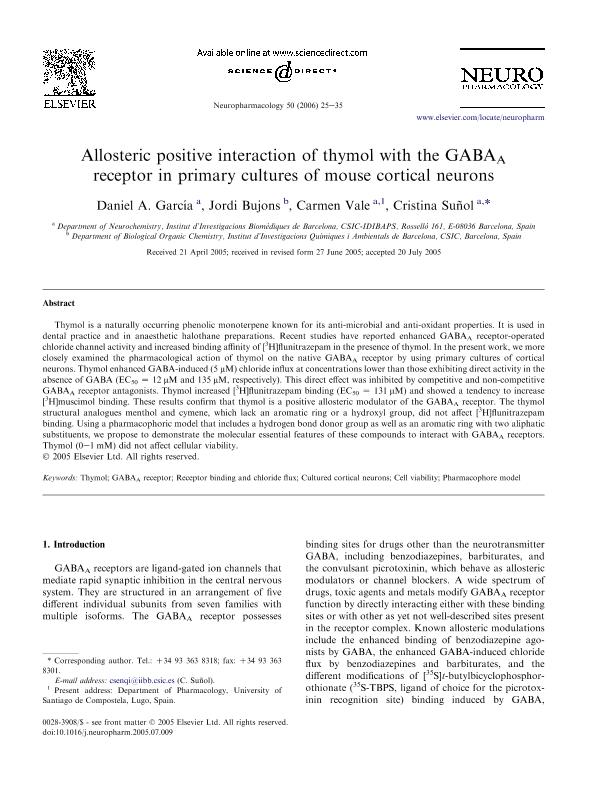Artículo
Allosteric positive interaction of thymol with the GABA-A receptor in primary cultures of mouse cortical neurons
Fecha de publicación:
01/2006
Editorial:
Pergamon-Elsevier Science Ltd
Revista:
Neuropharmacology
ISSN:
0028-3908
Idioma:
Inglés
Tipo de recurso:
Artículo publicado
Clasificación temática:
Resumen
Thymol is a naturally occurring phenolic monoterpene known for its anti-microbial and anti-oxidant properties. It is used in dental practice and in anaesthetic halothane preparations. Recent studies have reported enhanced GABAA receptor-operated chloride channel activity and increased binding affinity of [3H]flunitrazepam in the presence of thymol. In the present work, we more closely examined the pharmacological action of thymol on the native GABAA receptor by using primary cultures of cortical neurons. Thymol enhanced GABA-induced (5 μM) chloride influx at concentrations lower than those exhibiting direct activity in the absence of GABA (EC50 = 12 μM and 135 μM, respectively). This direct effect was inhibited by competitive and non-competitive GABAA receptor antagonists. Thymol increased [3H]flunitrazepam binding (EC50 = 131 μM) and showed a tendency to increase [ 3H]muscimol binding. These results confirm that thymol is a positive allosteric modulator of the GABAA receptor. The thymol structural analogues menthol and cymene, which lack an aromatic ring or a hydroxyl group, did not affect [3H]flunitrazepam binding. Using a pharmacophoric model that includes a hydrogen bond donor group as well as an aromatic ring with two aliphatic substituents, we propose to demonstrate the molecular essential features of these compounds to interact with GABAA receptors. Thymol (0-1 mM) did not affect cellular viability.
Archivos asociados
Licencia
Identificadores
Colecciones
Articulos(IIBYT)
Articulos de INSTITUTO DE INVESTIGACIONES BIOLOGICAS Y TECNOLOGICAS
Articulos de INSTITUTO DE INVESTIGACIONES BIOLOGICAS Y TECNOLOGICAS
Citación
Garcia, Daniel Asmed; Bujons, Jordi; Vale, Carmen; Suñol, Cristina; Allosteric positive interaction of thymol with the GABA-A receptor in primary cultures of mouse cortical neurons; Pergamon-Elsevier Science Ltd; Neuropharmacology; 50; 1; 1-2006; 25-35
Compartir
Altmétricas




